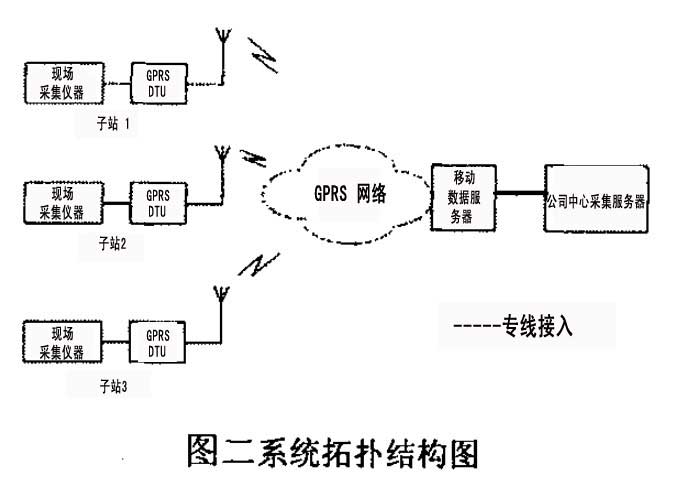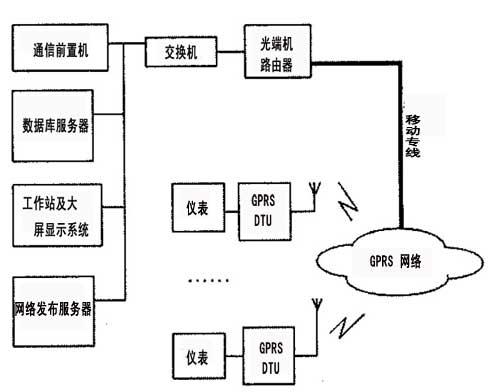

1、 GPRS overview
GPRS is the English abbreviation of general packet radio service. It is a new bearer service developed from the existing GSM system. Its purpose is to provide GSM users with packet data service. GPRS adopts the same wireless modulation standard, the same frequency band, the same burst structure, the same frequency hopping rules and the same TDMA frame structure as GSM. This new packet data channel is very similar to the current voice service channel of circuit text conversion. Therefore, the existing base station subsystem (BSS) can provide comprehensive GPRS coverage from the beginning.
2、 System introduction
1. GPRS features
A. Always online: as soon as GPRS DTU is turned on, it can automatically attach powder to GPRS network, establish communication link with your data center, and send and receive data from user data equipment at any time, with high real-time performance.
B. Billing by traffic: GPRS DTU is always online and charges according to the number of data packets received and sent. There is no charge when there is no data traffic.
C. High speed transmission: the maximum transmission speed of GPRS network can reach 160kbps, and the low speed depends on the setting of network operator Now, according to the situation of China Mobile, the transmission speed of the network can be set at 20-40kbps
D. Simple networking: GPRS wireless DDN can build a virtual mobile data communication dedicated network covering the whole country anytime and anywhere through the Internet network, provide transparent data transmission channels with the data center, and form a user dedicated data network to provide convenient access and low-cost communication methods for the majority of small and medium-sized enterprises.
E. Professional operators of communication link routing stack protection: due to the use of GPRS data service of China Mobile, link maintenance is also expensive by China Mobile, which eliminates the advantage of backward communication link maintenance.
F. Lightning protection: due to the GPRS data service of China Mobile, the transmission power of GPRS DTU is very small, the antenna is very short, and there is no need to be elevated without affecting the Internet. It overcomes the disadvantage that wired transmission and radio transmission are easy to cause lightning damage to the equipment.
2. Transmission efficiency
A. User data transmission efficiency (the proportion of user data in the total data of the network layer): DTU supports different networking methods and different packet lengths. At this time, there are different transmission efficiency. The following assumes that the maximum user packet length supported by the current longest DTU is 1024 bytes.
i. Only the data transmission axis initiated by DTU to the data center is supported: maximum transmission efficiency (W) = 97.3%
ii. Support two-way active mutual transmission. Maximum transmission efficiency (95.9% w)
B. Transmission axis delay (time between sending and receiving data): the delay of transmission is different for different packet lengths. According to the current mobile network conditions, generally, a packet with a packet length of 100 to 200 bytes can be transmitted to each other within 1 second. Packets larger than 200 bytes can be transmitted to each other in an average of 1 to 3 seconds.
3. Stability
A. Efficiency: the proportion of successfully transmitted data in the total transmitted data. According to the current use, under the normal condition of the network, the success rate of general data packets is more than 97%.
B. Stability comprehensive parameters: efficiency x transmission efficiency. There is an extremely important relationship between the effective bandwidth of the network and the maximum transmission unit (MTU). Generally, the increase of MTU to more than 200 bytes will not significantly increase the bandwidth, but will increase the average delay. The side test results show that the optimal size of MTU is about 200 bytes.
3、 System composition
1. Composition of field acquisition substation
The field acquisition sub station is connected with GPRS DTU transmission module by secondary instrument through RS-232 communication port. Each GPRS DTU transmission module can be loaded with a data SIM card of China Mobile.
2. Composition of main control room
The composition of the main control room is divided into two schemes:
1) The system topology is shown in Figure 1

Figure 1 system topology
The computer is directly connected with gprs modem to apply for a fixed IP address, and the data is accessed through wireless network card. This method is suitable for fewer acquisition points (about 200 acquisition points, about 100 bytes of data transmission each time, and the data acquisition interval of each sub station is not less than 1 minute; if the real-time requirements of the system are slightly lower, the data acquisition interval of each sub station can be greater than 1 minute, and the number of acquisition sub stations can be more.
2) The system topology is shown in Figure 2

Figure 2 system topology
The computer is connected with the data special line provided by China Mobile. The data is sent to the server of China Mobile and then transmitted to the computer in the main control room by the special line. This method is suitable for many acquisition points (more than 200), or although there are few acquisition points, but the real-time requirements are very high.
3. Scheme description
Both schemes adopt the same GPRS transmission mode.
★ the data acquisition sub station adopts the same transmission module, and the construction cost and operation cost of the sub station are the same
★ due to the use of mobile internal proprietary fixed IP address, the reliability, real-time performance and stability of the transmission system are the same;
★ both methods are based on GPRS networks that move all over the country, and the distribution range of sub stations is the same.
The difference between the two schemes is only in the access mode of the central server. Compared with scheme 2, scheme 1 has the following characteristics:
★ simple and low cost;
★ independent construction of enterprises, convenient and flexible, short construction cycle and quick effect;
★ since the center adopts wireless network card access, the network scale should not be too large;
★ the amount of data to be communicated is limited.
If the acquisition interval of each sub station is 5 minutes and the data packet collected each time is 100 bytes, the estimation is based on the central downlink bandwidth of 10kbps, and the system capacity is not less than 500 acquisition terminals.
Compared with scheme 1, the characteristics of central dedicated line access are as follows:
★ large system capacity;
★ the acquisition sub station has high communication rate and small acquisition interval;
★ each sub station can transmit a large amount of data.
Because the theoretical bandwidth of GPRS can reach 71 2kbps, the actual application bandwidth is about 10 - 40kbps. The center of scheme 2 adopts special line access, which overcomes the shortage of small capacity of scheme 1. If the downlink bandwidth of mobile dedicated line is 1Mbps, the acquisition interval of each sub station is 5 minutes, the data packet collected each time is 100 bytes, and the system capacity is not less than 3000. Two acquisition terminals.
4、 Software system
1. Software functions
Data list; Chart curve; Fault alarm; User data query; User data maintenance; Real time online; Safety settings; Financial statements; Common functions of user maps and other software.
2. System composition
The system consists of user acquisition terminal, company LAN and GPRS transmission network.
1) User acquisition terminal: it is composed of primary meter, secondary meter and GPRS transmission module. It collects the on-site operation parameters in real time and uploads them to the dispatching center.
2) Data acquisition LAN: it is composed of router, switch, database server and communication front-end computer.
a) Router: connect with mobile database server through optical fiber dedicated line;
b) Switch: connect the database server and various terminals in the LAN to realize data sharing in the LAN;
c) Database server: provide different access permissions according to the permissions of each user; According to the system authority, you can access the database, modify user parameters, add users, delete users and other operations, statistical reports, printing, etc;
d) Communication front-end processor: receive and process the data of each acquisition terminal;
e) Dispatching room workstation and management personnel terminal: you can access and browse the data of the collection terminal and view the network operation status;
f) Web publisher: provides ie browsing of data.
3) GRS transmission network: it provides the data upload channel of user acquisition terminal, and the network maintenance is completed by China Mobile.

GRS transmission network
4. Function planning:
1) Management module: user data and authority management;
2) Service module: used to collect data;
3) Query module: provide query of various data and conditions;
4) Statistics module: make corresponding reports according to different conditions;
5) Publishing module: used to support ie browsing;
6) Display module: used for data interface with large screen.
5、 Summary
The data remote monitoring system adopts GPRS as the communication means, and uses GPRS mobile data communication network to form a digital data transmission network, which provides users with permanent or semi permanent special circuits for high-quality and transparent data transmission at various rates, and establishes their own special data network for customers.

 销售王经理
销售王经理
 微信公众号
微信公众号